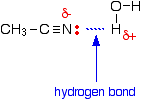|
INTRODUCING NITRILES This page explains what nitriles are and looks at their simple physical properties such as solubility and boiling points. What are nitriles? Nitriles contain the -CN group, and used to be known as cyanides. Some simple nitriles The smallest organic nitrile is ethanenitrile, CH3CN, (old name: methyl cyanide or acetonitrile - and sometimes now called ethanonitrile). Hydrogen cyanide, HCN, doesn't usually count as organic, even though it contains a carbon atom. The three simplest nitriles are:
 | ||||||||||||||||||||||
|
Note: Compounds like this are formed when aldehydes react with hydrogen cyanide. This is therefore the sort of branched nitrile that you are most likely to come across at this level. | ||||||||||||||||||||||
|
Physical properties
Boiling points The small nitriles are liquids at room temperature.
| ||||||||||||||||||||||
|
Note: The majority of the data sheets I have looked at quote this boiling range for butanenitrile. I don't know why it doesn't seem to have a precise boiling point. | ||||||||||||||||||||||
|
These boiling points are very high for the size of the molecules -
similar to what you would expect if they were capable of forming
hydrogen bonds. However, they don't form hydrogen bonds - they don't have a hydrogen atom directly attached to an electronegative element. They are just very polar molecules. The nitrogen is very electronegative and the electrons in the triple bond are very easily pulled towards the nitrogen end of the bond. Nitriles therefore have strong permanent dipole-dipole attractions as well as van der Waals dispersion forces between their molecules. | ||||||||||||||||||||||
|
Solubility
in water Ethanenitrile is completely soluble in water, and the solubility then falls as chain length increases.
One of the slightly positive hydrogen atoms in a water molecule is attracted to the lone pair on the nitrogen atom in a nitrile and a hydrogen bond is formed.  Forming these attractions releases energy. This helps to supply the energy needed to separate water molecule from water molecule and nitrile molecule from nitrile molecule before they can mix together. As chain lengths increase, the hydrocarbon parts of the nitrile molecules start to get in the way. By forcing themselves between water molecules, they break the relatively strong hydrogen bonds between water molecules without replacing them by anything as good. This makes the process energetically less profitable, and so solubility decreases.
| ||||||||||||||||||||||
Selasa, 12 Juni 2012
Langganan:
Posting Komentar (Atom)


great yara.. your blog give us information,,,
BalasHapusin this case i want ask you " how about nitries in the health.. ? plase give examole and it can make badsite for us?